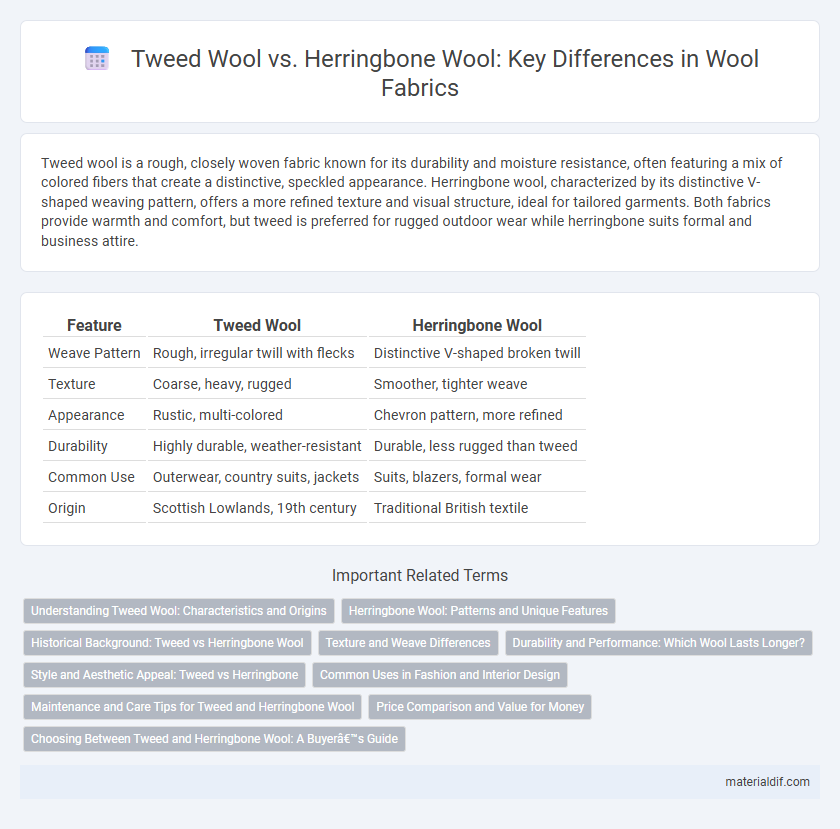Tweed wool is a rough, closely woven fabric known for its durability and moisture resistance, often featuring a mix of colored fibers that create a distinctive, speckled appearance. Herringbone wool, characterized by its distinctive V-shaped weaving pattern, offers a more refined texture and visual structure, ideal for tailored garments. Both fabrics provide warmth and comfort, but tweed is preferred for rugged outdoor wear while herringbone suits formal and business attire.
Table of Comparison
| Feature | Tweed Wool | Herringbone Wool |
|---|---|---|
| Weave Pattern | Rough, irregular twill with flecks | Distinctive V-shaped broken twill |
| Texture | Coarse, heavy, rugged | Smoother, tighter weave |
| Appearance | Rustic, multi-colored | Chevron pattern, more refined |
| Durability | Highly durable, weather-resistant | Durable, less rugged than tweed |
| Common Use | Outerwear, country suits, jackets | Suits, blazers, formal wear |
| Origin | Scottish Lowlands, 19th century | Traditional British textile |
Understanding Tweed Wool: Characteristics and Origins
Tweed wool originates from Scotland and is renowned for its rough, durable texture and distinctive multicolored flecks, making it ideal for outdoor wear in cooler climates. Its fabric is traditionally woven with a twill or plain weave, offering robustness and water resistance. Herringbone wool, a common tweed pattern, features a distinctive V-shaped weaving resembling a broken zigzag, enhancing both the fabric's texture and visual appeal while retaining tweed's characteristic durability.
Herringbone Wool: Patterns and Unique Features
Herringbone wool features a distinctive V-shaped weaving pattern resembling the bones of a herring fish, creating a textured and visually dynamic fabric. This pattern enhances durability and adds a subtle, elegant detail ideal for suits, jackets, and outerwear. Compared to tweed wool, herringbone offers a smoother finish with a more refined appearance while maintaining warmth and resilience.
Historical Background: Tweed vs Herringbone Wool
Tweed wool originated in the Scottish Highlands during the 19th century as a durable fabric designed to withstand harsh weather, often woven with multicolored yarns for distinctive patterns. Herringbone wool features a distinctive V-shaped weaving pattern derived from ancient Roman textiles, gaining popularity in British tailoring for its refined yet robust texture. Both fabrics hold deep historical significance in traditional menswear, but Tweed's rustic heritage contrasts with Herringbone's classical tailoring roots.
Texture and Weave Differences
Tweed wool features a rougher texture with a denser, more pronounced weave characterized by multicolored flecks, creating a rugged and rustic appearance. Herringbone wool displays a smoother texture and a distinct V-shaped zigzag pattern in its weave, giving it a refined and structured look. The tactile contrast between Tweed's coarse feel and Herringbone's sleek finish highlights their unique weaving techniques and textile aesthetics.
Durability and Performance: Which Wool Lasts Longer?
Tweed wool, known for its densely woven, rough texture, offers exceptional durability and resistance to daily wear, making it ideal for outdoor use and heavy-duty garments. Herringbone wool, characterized by its distinctive zigzag pattern, provides a smoother feel and moderate durability, often favored for stylish yet functional office wear. When comparing longevity, tweed wool typically outlasts herringbone wool due to its robust fiber structure and tighter weave, ensuring superior performance in harsh conditions.
Style and Aesthetic Appeal: Tweed vs Herringbone
Tweed wool features a rugged texture with a multicolored, speckled appearance that conveys a timeless, rustic charm ideal for classic countryside fashion. Herringbone wool displays a distinct V-shaped weaving pattern, offering a sleek, structured look that enhances sophistication and versatility in urban or formal wear. Both fabrics provide unique aesthetic appeals, with tweed emphasizing warmth and nostalgia while herringbone prioritizes refined elegance and subtle complexity.
Common Uses in Fashion and Interior Design
Tweed wool, known for its coarse texture and durability, is frequently used in outerwear such as jackets and coats, as well as upholstery and rustic home decor emphasizing a traditional aesthetic. Herringbone wool features a distinctive V-shaped pattern and slightly finer weave, making it popular for tailored suits, blazers, and sophisticated interior elements like cushions and drapery. Both fabrics provide warmth and texture but cater to different stylistic preferences in fashion and interior design.
Maintenance and Care Tips for Tweed and Herringbone Wool
Tweed wool requires regular brushing with a soft garment brush to remove dirt and prevent moth damage, while herringbone wool benefits from gentle spot cleaning and airing out to maintain its texture and prevent odor buildup. Both fabrics should be dry cleaned infrequently to avoid damaging the natural oils in the wool fibers, enhancing longevity and softness. Proper storage in breathable garment bags with cedar blocks or lavender sachets protects against moisture and pests for tweed and herringbone wool garments.
Price Comparison and Value for Money
Tweed wool generally commands a higher price due to its complex weaving process and traditional craftsmanship, making it a premium choice for durable outerwear. Herringbone wool, while often more affordable, offers excellent value for money with its distinctive V-shaped pattern and versatility in both casual and formal attire. Consumers seeking long-lasting quality and classic style may find the higher investment in tweed wool justified, whereas herringbone wool provides an economical option without compromising on aesthetic appeal.
Choosing Between Tweed and Herringbone Wool: A Buyer’s Guide
Tweed wool features a rough, textured surface with multicolored yarns that offer durability and a classic, rustic aesthetic, ideal for outdoor wear and traditional styles. Herringbone wool showcases a distinctive V-shaped weaving pattern that provides a smoother finish and a sophisticated look suitable for formal and business attire. Buyers should consider intended use, desired texture, and pattern preference when choosing between the rugged, earthy appeal of tweed and the sleek, structured appearance of herringbone wool.
Tweed Wool vs Herringbone Wool Infographic

 materialdif.com
materialdif.com